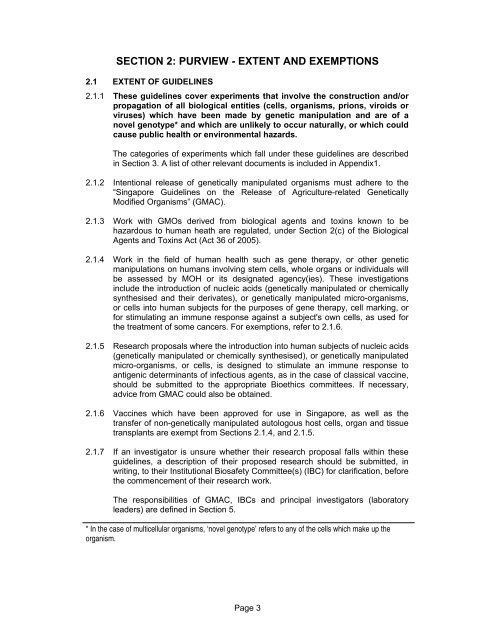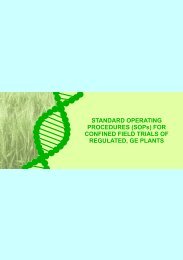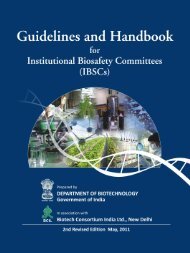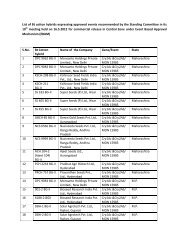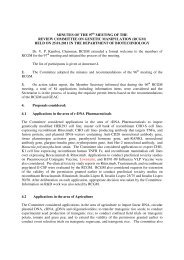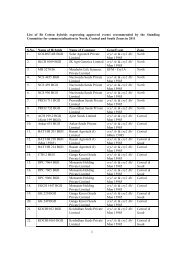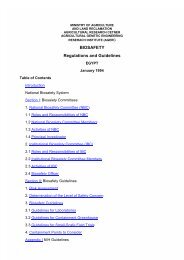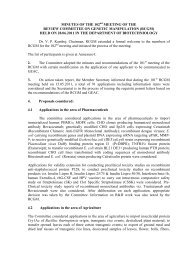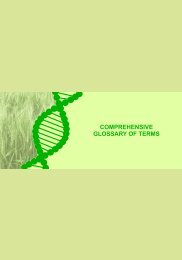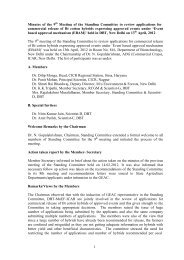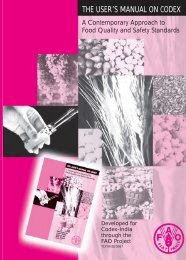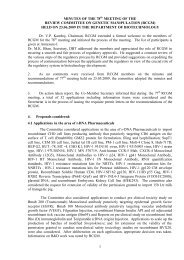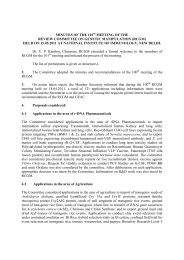Biosafety Guidelines For Research On Genetically Modified ...
Biosafety Guidelines For Research On Genetically Modified ...
Biosafety Guidelines For Research On Genetically Modified ...
Create successful ePaper yourself
Turn your PDF publications into a flip-book with our unique Google optimized e-Paper software.
SECTION 2: PURVIEW - EXTENT AND EXEMPTIONS<br />
2.1 EXTENT OF GUIDELINES<br />
2.1.1 These guidelines cover experiments that involve the construction and/or<br />
propagation of all biological entities (cells, organisms, prions, viroids or<br />
viruses) which have been made by genetic manipulation and are of a<br />
novel genotype* and which are unlikely to occur naturally, or which could<br />
cause public health or environmental hazards.<br />
The categories of experiments which fall under these guidelines are described<br />
in Section 3. A list of other relevant documents is included in Appendix1.<br />
2.1.2 Intentional release of genetically manipulated organisms must adhere to the<br />
“Singapore <strong>Guidelines</strong> on the Release of Agriculture-related <strong>Genetically</strong><br />
<strong>Modified</strong> Organisms” (GMAC).<br />
2.1.3 Work with GMOs derived from biological agents and toxins known to be<br />
hazardous to human heath are regulated, under Section 2(c) of the Biological<br />
Agents and Toxins Act (Act 36 of 2005).<br />
2.1.4 Work in the field of human health such as gene therapy, or other genetic<br />
manipulations on humans involving stem cells, whole organs or individuals will<br />
be assessed by MOH or its designated agency(ies). These investigations<br />
include the introduction of nucleic acids (genetically manipulated or chemically<br />
synthesised and their derivates), or genetically manipulated micro-organisms,<br />
or cells into human subjects for the purposes of gene therapy, cell marking, or<br />
for stimulating an immune response against a subject's own cells, as used for<br />
the treatment of some cancers. <strong>For</strong> exemptions, refer to 2.1.6.<br />
2.1.5 <strong>Research</strong> proposals where the introduction into human subjects of nucleic acids<br />
(genetically manipulated or chemically synthesised), or genetically manipulated<br />
micro-organisms, or cells, is designed to stimulate an immune response to<br />
antigenic determinants of infectious agents, as in the case of classical vaccine,<br />
should be submitted to the appropriate Bioethics committees. If necessary,<br />
advice from GMAC could also be obtained.<br />
2.1.6 Vaccines which have been approved for use in Singapore, as well as the<br />
transfer of non-genetically manipulated autologous host cells, organ and tissue<br />
transplants are exempt from Sections 2.1.4, and 2.1.5.<br />
2.1.7 If an investigator is unsure whether their research proposal falls within these<br />
guidelines, a description of their proposed research should be submitted, in<br />
writing, to their Institutional <strong>Biosafety</strong> Committee(s) (IBC) for clarification, before<br />
the commencement of their research work.<br />
The responsibilities of GMAC, IBCs and principal investigators (laboratory<br />
leaders) are defined in Section 5.<br />
* In the case of multicellular organisms, ‘novel genotype’ refers to any of the cells which make up the<br />
organism.<br />
Page 3


